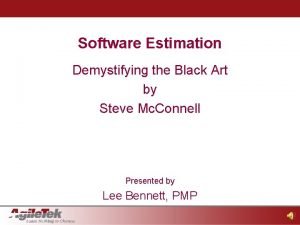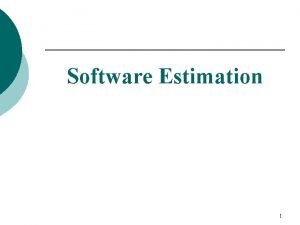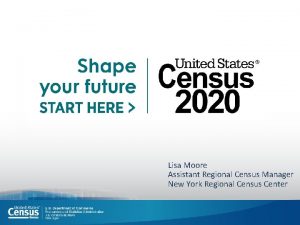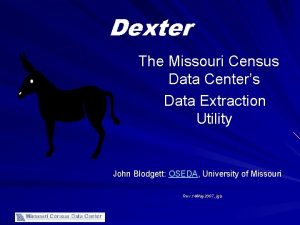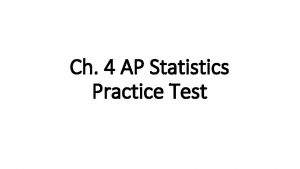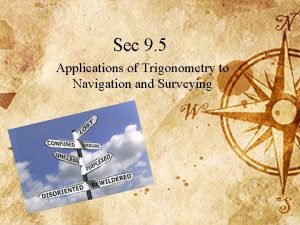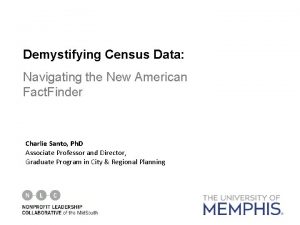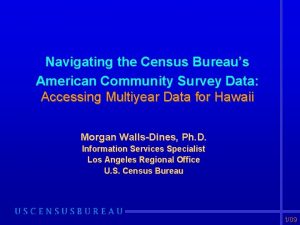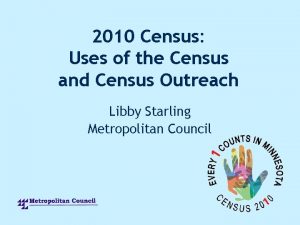Demystifying Census Data Navigating the New American Fact












- Slides: 12

Demystifying Census Data: Navigating the New American Fact. Finder Charlie Santo, Ph. D Associate Professor and Director, Graduate Program in City & Regional Planning

Where does the data come from? Old Model New Model Decennial Census Short Form (100%) Short form only (100%) Long Form (1 in 6 sample) NO LONG FORM Continuous American Community Survey

2000 short form 2000 long form


2010 Census form ACS Form


Table Naming Conventions Decennial Census American Community Survey P: Population Variables (People) B: Base (detailed) Table H: Housing Variable C: Collapsed (version of a base table) DP: Demographic Profile (includes more than one variable) GCT: Geographic Comparison Table R: Ranking Table QT: Quick table (includes some calculations) S: Select Population Profile

Table Naming Conventions BASIC tables (raw data) Decennial Census American Community Survey P: Population Variables (People) B: Base (detailed) Table H: Housing Variable C: Collapsed (version of a base table) DP: Demographic Profile (includes more than one variable) GCT: Geographic Comparison Table R: Ranking Table QT: Quick table (includes some calculations) S: Select Population Profile

Table Naming Conventions Decennial Census American Community Survey P: Population Variables (People) B: Base (detailed) Table H: Housing Variable C: Collapsed (version of a base table) DP: Demographic Profile (includes more than one variable) GCT: Geographic Comparison Table R: Ranking Table QT: Quick table (includes some calculations) “Manipulated” Data S: Select Population Profile NP: Narrative Profile

• 2000 SF 1 Technical Documentation (with table/variable names) • 2000 SF 3 Technical Documentation • 2010 SF 1 Technical Documentation • 2006 -2010 ACS 5 -year Summary Technical Documentation • ACS Table Codes

Census Geography Hierarchy (with 2010 Statistical Area Criteria) Central axis describes a nesting relationship • Cities and towns -- incorporated • Census Designated Places (CDPs) • 1, 200 to 8, 000 population (optimum 4, 000) • 480 to 3, 200 housing units Blocks are not defined by population and are the smallest geographic level at which data are ever released (Decennial Census, not the ACS) • 600 to 3, 000 population • 240 to 1, 200 housing units

http: //factfinder 2. census. gov/
 Demystifying healthcare data governance
Demystifying healthcare data governance Software estimation demystifying the black art
Software estimation demystifying the black art Demystifying the cloud
Demystifying the cloud Software estimation demystifying the black art
Software estimation demystifying the black art Demystifying face recognition
Demystifying face recognition New york regional census center
New york regional census center Missouri census data center
Missouri census data center Tonya wanted to estimate the average amount
Tonya wanted to estimate the average amount Navigating the body muscular system #3
Navigating the body muscular system #3 Digital landscape model
Digital landscape model What is the purpose of liquid in the capsule of a compass?
What is the purpose of liquid in the capsule of a compass? Applications of trigonometry in navigation
Applications of trigonometry in navigation Aws cognito gdpr
Aws cognito gdpr

